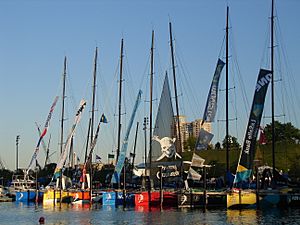The Ocean Race facts for kids
 |
|
| Formerly |
|
|---|---|
| Sponsor | Volvo |
| Partner | Inmarsat |
| First held | 1973 |
| Yachts used | Volvo Ocean 65 IMOCA 60 (Since 2021) |
| Start | 2023 |
| Finish | 2023 |
| Competitors | 7 |
| Legs | 10 |
| Champion | 2023 2023 |
The Ocean Race is a super exciting yacht race that goes all the way around the world! It happens every three or four years. The first race was in 1973.
It used to be called the Whitbread Round the World Race. This was because a British company called Whitbread sponsored it. Later, in 2001, a Swedish car company named Volvo became the sponsor. So, the race changed its name to the Volvo Ocean Race. In 2019, it got its current name, The Ocean Race.
Each team has a sailing crew. They race day and night for more than 20 days on some parts of the journey. Since the 2008–2009 race, there's also been a special person on board. This person is called the On Board Reporter (OBR). Their job is to send cool pictures and videos from the middle of the ocean. They use satellites to send these back to race headquarters. The OBR does not help sail the boat.
To keep the boats light, the crews mostly eat freeze-dried food. This food is very light and easy to store. Sailors also deal with big temperature changes. It can be as cold as -5 degrees Celsius or as hot as +40 degrees Celsius. They often only bring one extra set of clothes to save weight.
Contents
The Race's Amazing History
In 1972, a company from England called Whitbread teamed up with the British Royal Naval Sailing Association. They decided to create a big sailing race around the world. They named it the 'Whitbread Round the World Yacht Race'.

The very first race started on September 8, 1973. It began in Portsmouth, United Kingdom. 17 yachts and 167 crew members took part. The race covered about 27,500 nautical miles (which is about 50,930 kilometers). Around 3,000 spectator boats came to watch the start! A Mexican amateur sailor named Ramon Carlin won the first race. His yacht was called Sayula II.
The first race route followed the paths of old square rigger ships. These ships carried goods around the world in the 1800s.
In 2001, Volvo and Volvo Cars took over the race. That's when it became the ‘Volvo Ocean Race’. New stopover cities were added in Germany, France, and Sweden. These were important car markets for Volvo in Europe.
Winning this race does not come with a cash prize. The amazing achievement of finishing the race is considered the main reward. Many sailors in The Ocean Race also compete in other big events. These include the Olympic Games or the America's Cup.
The toughest weather is usually found in the Southern Ocean. Waves there can sometimes be as high as 150 feet (about 45 meters). Winds can blow at speeds up to 70 knots (about 130 kilometers per hour).
The 2017–18 race was the longest ever. It covered 45,000 nautical miles (about 83,340 kilometers).
The Special Yachts Used
In the early races, many different types of boats were used. But after the 1989–1990 race, things changed. They decided to use a single type of boat called the Whitbread 60. This was because the biggest boats, called "maxi" boats, were becoming very expensive. They also had a huge advantage over smaller boats. For example, Steinlager 2 won every part of the race in its division.
The Whitbread 60 design was used for all smaller boats in the 1993–1994 race. Then, it was used for all boats in the 1997–1998 race. The race continued to use only one type of boat for the next seven races. These boats were first the Volvo Open 70, and then the Volvo Ocean 65.
For the 2023 race, two different types of boats were used. These were the Volvo Ocean 65 and the IMOCA 60.
The Race Route Around the World
The race route changes a bit each time to visit different cities. But it usually starts in Europe in October. In recent races, it has had 9 or 10 parts, called "legs." There are also shorter "in-port" races in many of the stopover cities.
The 2008–2009 race began in Alicante, Spain, on October 11, 2008. This route was different from earlier ones. It included stops in India and Asia for the first time. The 2008–09 race covered almost 39,000 nautical miles (about 72,228 kilometers). It took over nine months to finish. About 2 billion people around the world watched it on TV!
The 2011–12 Volvo Ocean Race also started in Alicante, Spain, in October 2011. It ended in Galway, Ireland, in July 2012. Teams sailed over 39,000 nautical miles. They went through some of the world's most dangerous seas. They visited places like Cape Town, Abu Dhabi, Sanya, Auckland, and around Cape Horn.
The 2014–15 Volvo Ocean Race also started in Alicante, Spain, on October 11. It finished in Gothenburg, Sweden, in June 2015. Along the way, boats stopped in cities like Cape Town, Abu Dhabi, Auckland, and Newport.
Past Races and Winners
| Edition | Start | Finish | Boat Type | Legs | In-Port Races | Entries | Winning Yacht | Winning Skipper |
|---|---|---|---|---|---|---|---|---|
| 1973–74 | 32-80 ft (10-24 m) | 4 | 0 | 17 | ||||
| 1977–78 | 51-77 ft (16-23 m) | 4 | 0 | 15 | ||||
| 1981–82 | 43-80 ft (13-24 m) | 4 | 0 | 29 | ||||
| 1985–86 | 49-83 ft (15-25 m) | 4 | 0 | 15 | ||||
| 1989–90 | 51-84 ft (16-26 m) | 6 | 0 | 23 | ||||
| 1993–94 | 85 ft (26 m) ketchs | 6 | 0 | 5 | ||||
| Whitbread 60 | 10 | |||||||
| 1997–98 | Whitbread 60 | 9 | 0 | 10 | ||||
| 2001–02 | Whitbread 60 | 9 | 0 | 8 | ||||
| 2005–06 | Volvo Open 70 | 9 | 7 | 7 | ||||
| 2008–09 | Volvo Open 70 | 10 | 7 | 8 | ||||
| 2011–12 | Volvo Open 70 | 9 | 10 | 6 | ||||
| 2014–15 | Volvo Ocean 65 | 9 | 10 | 7 | ||||
| 2017–18 | Volvo Ocean 65 | 10 | 12 | 7 | ||||
| 2023 | IMOCA 60 | 7 | 7 | 5 | ||||
| Volvo Ocean 65 | 3 | 4 | 6 | |||||
| 2027 | IMOCA 60 | A 15th edition has been announced with a start in Alicante in early 2027 | ||||||
| 2031 | IMOCA 60 | A 16th edition has been announced with a start in early 2031 | ||||||
Cool Race Records
- The Netherlands is the only country to have won the race three times.
- Conny van Rietschoten is the only skipper (captain) to win the race twice.
- The yacht Steinlager 2 is the only boat to ever win all six legs of a race.
The Horrevoets Trophy
In May 2009, The Ocean Race started a special award. It's called the Hans Horrevoets Rookie Award. This award celebrates the best sailor under 30 years old in each race. The team captains choose who wins.
Here are some of the winners:
- 2008–09 - Michael "Michi" Mueller - Puma Ocean Racing
- 2011–12 - David "Dave" Swete - Team Sanya
- 2014–15 - Sophie Ciszek - Team SCA
- 2017–18 - Bleddyn Mon - Turn the Tide on Plastic
- 2023–23 - Will Harris - Team Malizia
See also
 In Spanish: The Ocean Race para niños
In Spanish: The Ocean Race para niños
- List of Volvo Ocean Race sailors
- The Ocean Race Europe
- Ocean Globe Race, a race that celebrates the 50th anniversary of the first Whitbread Round the World Race.


